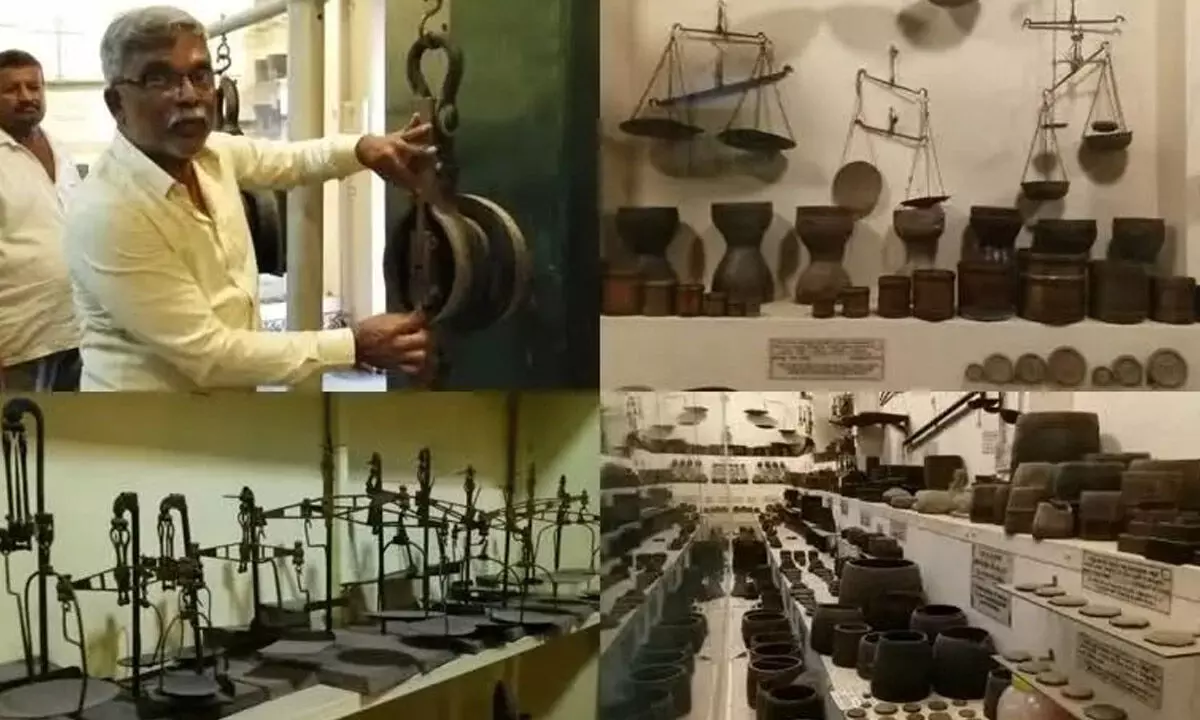Live
- ‘Ustaad’ and ‘Polimera 2’ Win Big at Dada Saheb Film Festival
- Soft skills are the key to women’s success at modern workplace
- Study shows premature surgical menopause may raise muscle disorder risk
- Pawan Kalyan's ‘Hari Hara Veera Mallu’ Teaser Release Date Confirmed for May 2nd
- FirstCry CEO’s remuneration drops 49 per cent to Rs 8.6 crore a month
- Kalki 2898 AD: Prabhas’ IPL Promo Sparks Frenzy, Watch Video
- IPL 2024: 'The only person who has to pay the price...', Brett Lee slams LSG for mishandling Mayank's injury
- BRS looted Telangana, says MLA Yashaswini Reddy
- Cong failed to implement promises: Vinod Kumar
- Baahubali-Crown of Blood: SS Rajamouli Announces Animated Series, Trailer to Release Soon
Just In
Davangere's ancient weight and measuring equipment museum, first in India


Davangere’s ancient weight and measuring equipment museum, first in India
Open for public, this museum is named ‘Kula Bhavan’ and various tools of BC and AD era have been collected and neatly arranged in the museum
Davangere: There is a shop selling weighing and measuring tools in Chamarajpet, a busy area of KR market in Davanagere city. The uniqueness of this shop is that the owner has set up a museum of ancient weight and measurement equipment at first floor of his shop. This is really a rare collection of measuring and weighing materials used from ancient times till today.
The shop owner enthusiast Basavaraj Yalamalli has collected various tools of weighing and measuring which is said to be the first in the country. This museum is named 'Kula Bhavan' and various tools of BC and AD 1600 have been collected and neatly arranged in the museum. Most of the devices have their time, name information mentioned below. Basavaraj Yalamalli said that information is being collected to collect some other tools.
This museum has been constructed to collect and store the instruments of measurement and weight. The family of Basavaraja Yalamalli (54), who founded it, had been running the business of weights and measures. This shop was started during the time of father Channaveerappa Yalamalli. Basavaraj, who has been running the business for 25 years, got the idea why not to make a collection of weights and measures as a hobby along with his profession. He used to collect postage stamps before taking up this hobby and has also won a bronze medal at the national level for his postage stamp exhibition on Mahatma Gandhi. Desperate to do something new, he collected weighing tools. What is special is that all the tools assembled in this museum are in good condition.
"Collecting information related to weights and depth instruments was a challenging task. Even if I scoured the internet, the information available was very little. There was not much mention of the use of weight instruments in the history books. So, I travelled across the country with the intention of collecting everything from the source. In all the states except Jammu and Kashmir, North Eastern states, . some were heard and acquired. Some were bought from rummage shops, antique dealers. This field experience inspired me to write a book 'History and Legacy of Weights and Rulers Achievements in 2010'. This book is the first guide to collection of weights and measures. " says Basavaraj.
Tools used in BC, AD era
One can see here under one roof all the weight and measurement tools made in the country, abroad, and in the royal families. There is a rare 18th century scale. It was used to weigh silver and gold items. It was used during the rule of Sultans in Vijayapura, Bidar, Kalaburagi, Raichur. Also there is a collection of gooseberry shaped weights made of brass. Also here are the octagonal brass bowls used in the Dakshina Kannada district , the square brass bowls used in the Haveri area, the hippale scales of the Keladi kingdom , the Nizam dynasty, the Mysore rulers, the bell weights, the rectangular artha mana with the Gandabherunda emblem, and the four mana iron balls. Here one can see iron and brass beam sails (weighing in hand) of different states of the country, Dakshina Kannada oil gauges, bamboo scales used for measuring ola fish.
Scales used in post offices
There is a separate section of scales of different capacities and models used in post offices in the museum. Brass and tin scales of Mumbai, Goa, Kolkata, Tamil Nadu, Goa Portuguese, Mughals, Adil Shahis, Peshwas, Hyderabad Nizams can be found here. In total, tools used in more than 60 kingdoms of the country, weighing machines made in England, Germany, America, various types of weights used in the British period, various types of machines for measuring human weight are also here.
The Channaveerappa Yalamalli Trust, which consists of four directors, has collected 700-year-old artefacts for the maintenance of this museum. The museum is open for public also, says Basavaraj.

© 2024 Hyderabad Media House Limited/The Hans India. All rights reserved. Powered by hocalwire.com






